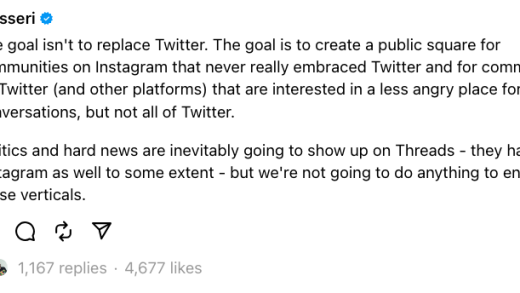Denny O’Neill and Neal Adams’s 1970s run on Green Lantern (often called Green Lantern/Green Arrow) is rightfully considered one of the most groundbreaking and iconic comics runs of all time. Over the course of 13 issues, they tackled the pressing social justice issues of the day (and today), like racism, environmentalism, wealth inequality, and the housing crisis. They introduced John Stewart, one of DC’s first Black superheroes, and pushed the boundaries of how comics could address controversial topics like drug addiction.
And in #83, their heroes fought a little girl who was also Richard Nixon.
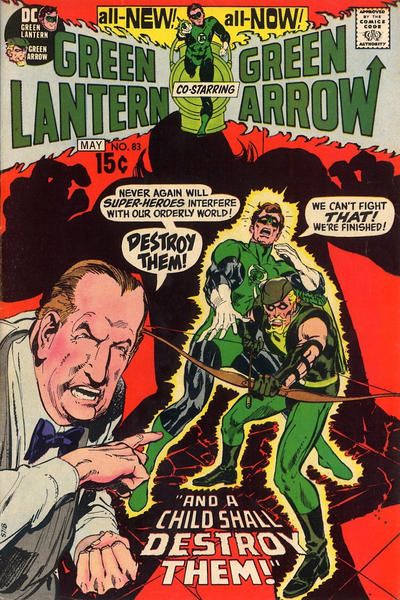 |
At first glance, Green Lantern #83 isn’t nearly as overtly political as some of the other stories in the O’Neil/Adams run — at least, not if you were born a full decade after Nixon resigned, to pick the random example of me. Instead, it reads more like straightforward horror.
The story begins with an older man bumping into a young woman. He snaps at her, and when she refuses to apologize because the collision was his fault, he tells the little girl with him, Sybil, to “do something to her.” “Yes, Grandy,” Sybil replies, her eyes glowing. The woman doubles over in pain.
A month later, Dinah Lance (aka Black Canary) arrives at the Meadowhill School with Oliver Queen (Green Arrow) and Hal Jordan (Green Lantern). Dinah has taken a job at the school but is immediately put off by the creepy vibes surrounding the place. (There’s even a Hitchcock cameo right after the trio is attacked by — what else? — birds.)
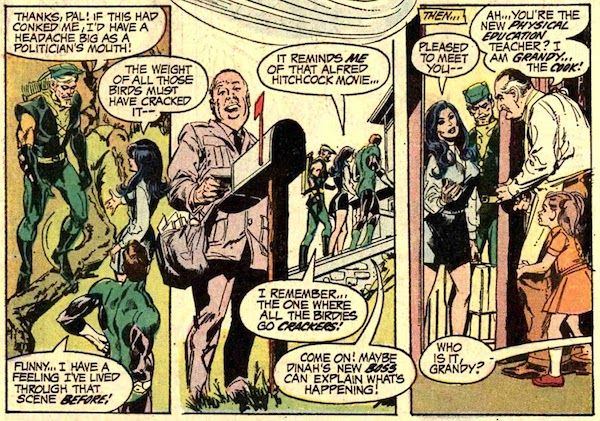 |
Inside the school, they meet the headmaster, Jason Belmore, as well as the cook…Grandy. The reader knows Grandy is trouble, but Hal is more concerned by Belmore since he knows Belmore was engaged to Hal’s ex, Carol Ferris. He’s still surprised to run into Carol outside and even more surprised to see that she’s now using a wheelchair. She explains that a month ago, she had an inexplicable seizure and hasn’t been able to walk since. That’s right — Carol was the woman Sybil attacked on the first page. In the middle of Carol’s explanation, the car Ollie is driving suddenly falls apart, leaving both men certain that there is something very, very wrong at Meadowhill.
Dinah, meanwhile, is having an even creepier experience. After she dismisses her students early, Grandy tells her such things aren’t done at Meadowhill and that he’ll have to “punish” her. Alarmed, Dinah switches to her Black Canary gear — but she’s still no match for Sybil, who knocks her out on Grandy’s command.
When Dinah comes to, she’s trapped in the basement, and Grandy is threatening her with a wasp nest. Dinah asks who and what he and Sybil are. “You can say I’m a person who wants order!” Grandy explains, and Sybil is an orphan he found in the woods. Then he smashes the wasp nest and locks the door with Dinah inside.
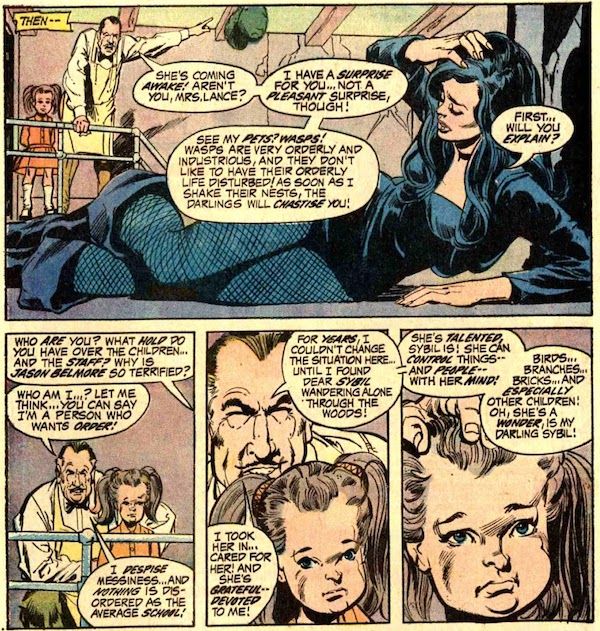 |
Luckily, Hal and Ollie have returned. A terrified Belmore tells them what’s going on, and they race to the rescue — but Grandy sics the zombified student body on them, and then Sybil. Hearing Dinah’s screams, Ollie fights through the pain and fires a “vortex arrow.” I have no idea what that is or why he has it, but the “lights and sounds” coming from it (seriously, what?) break Sybil’s concentration.
While Ollie sees to Dinah, Hal handles the wasps. Realizing that Grandy and Sybil must be behind Carol’s seizure, he tries to arrest them. Grandy orders Sybil to “make him sorry”…and she refuses.
“I hurt, Grandy!” she says. “You ask me to do things that hurt…I want to be like other children!”
Grandy slaps her. This is a bad idea.
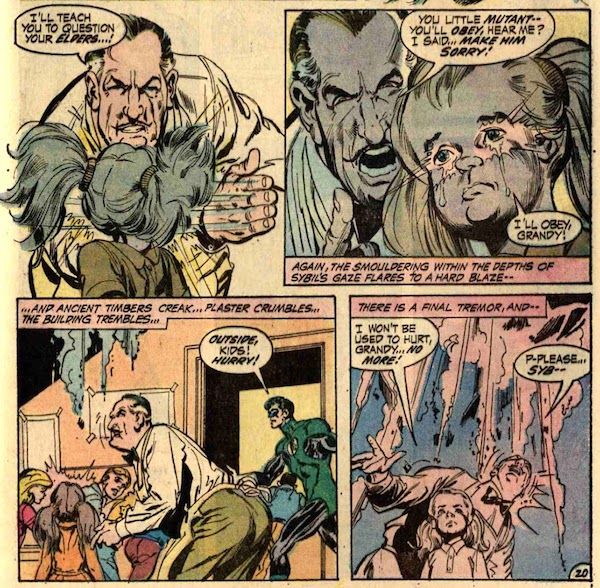 |
She goes full Carrie, using her power to collapse part of the building (specifically the west wing…get it?). Luckily, everyone gets out in time…except for Sybil and Grandy. Hal, seeing the strength of Ollie and Dinah’s love for each other, finally confesses his secret identity to Carol, and they reunite. (Sorry, Belmore.) The last panel shows Hal walking away, with Carol in his arms…and in the foreground, Sybil’s feet and the caption “The End?” (It is, though — Sybil hasn’t turned up again in the ensuing 52 years.)
Yeah, so Sybil is Richard Nixon, and Grandy is Spiro Agnew. I mean, look at them!
Like I hinted at the beginning of this article, I didn’t recognize either caricature the first time I read this comic. Or the second time. Or the third. I’d like to blame it on the tiny little mustache-of-plausible-deniability Adams gave Grandy on the interior pages (but not the cover, for some reason), but the truth is, it took reading this blog post by comics historian Alan Stewart, who was a teenager when Green Lantern #83 came out and much better placed to pick up on the subtext, for me to understand what this comic was really about. Even the gimme line “The whole west wing is in ruins!” didn’t help me.
Of course, Watergate was well before my time. The power dynamics between the characters are also misleading. To a modern reader, the casting of Agnew as the mastermind and Nixon as a victim whose power Agnew is exploiting seems arbitrary at best. After all, who cares about Spiro Agnew?
As Stewart explains, though, Agnew had a reputation at the time as Nixon’s “hatchet man,” attacking critics of the administration — particularly young people and anti-war protesters, two groups with an obvious overlap. He frequently railed against overly permissive parenting and in favor of law and order. Stewart highlights a 1970 speech in which Agnew drew a direct line from allowing a child to come to dinner with unkempt hair to that child growing up to become, uh, an arsonist. Okay, Spiro!
Anyway, this context makes it a bit easier to understand why the relatively young and certainly liberal O’Neil and Adams — 32 and 30 when this comic came out, respectively — would have disliked Agnew enough to make him the target of their satire. And when you look at Grandy’s rants about messiness, disorder, and disobedient women, the satire feels a bit more rooted in Agnew’s actual rhetoric.
Even if I didn’t catch the snap the first time I read this issue, contemporary readers picked up on…well, some of it. A former governor of Florida, Claude R. Kirk, Jr., sent a furious letter to DC about how such disrespect towards the vice president would ruin children’s minds, and if they ever did it again, he would ensure that DC Comics would no longer be distributed in the state. (Florida, clearly, hasn’t changed one bit.) As Adams tells it, he just laughed and pointed out that Kirk hadn’t even noticed the Nixon parody.
Green Lantern #83 obviously didn’t oust either Nixon or Agnew from office — they did that to themselves — and I suspect the political commentary of the issue is largely lost on modern readers, as it was on me. But this sort of thing is one of the many reasons I love comics. Superheroes are timeless, but superhero comics are ephemeral, disposable media meant for the specific month in which they’re published. And sometimes, they can capture the mood of a particular moment in time, half a century ago, before our nation’s most infamous political scandal changed everyone’s perspective on the relevant parties.
Plus, baby girl Nixon is freaking hilarious.
 |
Source : That Time Green Lantern Fought a Little Girl Who Was Also Richard Nixon



